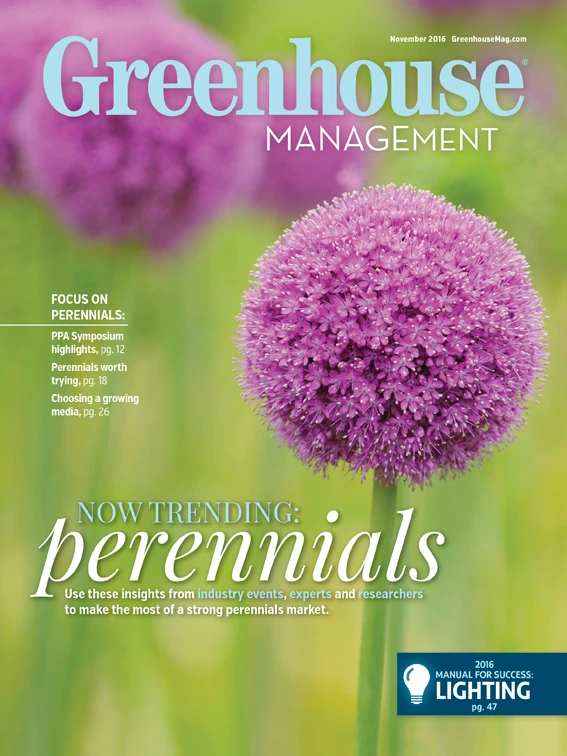
Many types of media have been utilized in the production of perennials historically, and a wide range of product options are available for growers to choose from today. Perennial plants are grown from seed, rooted cuttings and bare root plants, and are then potted up into quart, gallon and larger sizes. The selected container size would depend on plant size and vigor. Of course, decisions on container size should take into account the anticipated growth of the plant and its marketing considerations.
Several additional challenges face perennial producers when making media choices. One of these is selecting a media that will accommodate the diversity of perennials being produced. Some of the perennial genera and species have fibrous root systems such as Dianthus, and some have thicker fleshy roots like daylilies. Selecting a single media type may be difficult in order to provide the best results for production, but watering practices can be adjusted to accommodate a number of species in the same medium.
Operations producing large quantities of perennials may select several products to cover the plant diversity in their production situation. If the operation is large enough it may be making its own media, or growers can use custom blends obtained from custom blending companies. Other firms purchase bagged media from one of the commercial media producers. Smaller operations may be better off economically by using one of the commercially available bagged blends.
Sifting through the options
While the options are numerous, the medium selected for perennials may differ from media selected for production of bedding plants in flats. Larger containers benefit from increased porosity within the medium, providing sufficient oxygen for developing root systems. Media manufacturers have a number of products designed for different applications, including larger sized plant production. A medium providing a 15 to 20 percent air space and 30 to 40 percent water-holding capacity for a total of 45 to 60 percent total porosity would be suitable for perennial production.
The pore space in a medium is determined by the ratio and sizes of ingredients in that medium. Total porosity is equal to the volume of water added to a dry medium in a container divided by the volume of the container. The air space in a medium is that space which held the water added, when drained after a few minutes’ time (% air = volume of water drained/volume of container). Subtracting the volume of water drained from the volume of water added initially provides the water-holding capacity of the medium. Potting media providers are quite knowledgeable about these qualities of their products and can provide porosity information.
Media porosity is an important part of plant production, and is managed in concert with watering practices and fertility programs for success in perennial plant production. A change in medium would in all likelihood require a change in watering practices. Wind velocity, temperature and level of light intensity on the crop would also influence the rate of water use. Plants growing in higher stress situations from wind, temperature and light would require greater moisture-holding capacity in the medium compared to plants growing under lower stress levels.
A real-life example
As an example of this interplay between media porosity and watering practices, let’s look at the Penn State Flower Trials in Manheim, Penn. The summer climate is hot and humid, and the site has open exposure and considerable wind stress.
In 2016, more than 1,100 selections of plants were tested in more than 2,800 5-gallon containers. Both annual and perennial plants are evaluated. Plants are grown in these containers for 120 days, from May through September, on black ground cloth. Plants are irrigated on the drip system and initially watered once a day, saturating the containers. As the season progresses, the watering frequency increases to two times daily to accommodate the increased growth and increased transpiration rates of the plants.
Under these conditions, it is important to provide a suitable water-holding capacity in the media; the medium used for this purpose has a 13 percent air space volume and a 64 percent water-holding volume, for 77 percent total porosity.
In 2016, the temperatures in July, August and early September were consistently above average, and plant stress was much greater as a result. With a 64 percent moisture retention capacity in the media, most plants did well, but a lower percentage would have been a problem. Some heat-intolerant species did poorly after a long period of 90°F temperatures, and some species required a third irrigation in peak stress periods.
In selecting a medium for herbaceous perennials, consider how the medium will perform with the irrigation system, the plants to be produced, the fertility plan and the environmental situation where production will take place. Remember there is no perfect medium, only better or worse choices for a production system. Choosing the best medium for your system is important for successful perennial production.

Explore the November 2016 Issue
Check out more from this issue and find your next story to read.
Latest from Greenhouse Management
- Grant awarded to test western U.S. wood species for use as wood fiber potting substrate
- Pennsylvania Horticultural Society announces 2025 Gold Medal Plant winners
- Oasis Grower Solutions announces new Southeast territory sales manager
- A nation of gardeners: A history of the British horticulture industry
- Last Word with Angela Labrum, Bailey Nurseries
- Iowa plant supplier Plantpeddler building retail complex
- This month's Greenhouse Management magazine is about native plants and sustainability
- The HC Companies, Classic Home & Garden merge as Growscape





